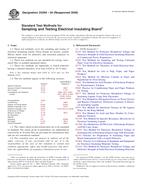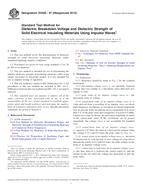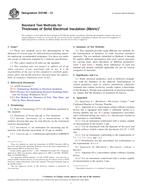Potrebujeme váš súhlas na využitie jednotlivých dát, aby sa vám okrem iného mohli ukazovať informácie týkajúce sa vašich záujmov. Súhlas udelíte kliknutím na tlačidlo „OK“.
ASTM D2520-13
Standard Test Methods for Complex Permittivity (Dielectric Constant) of Solid Electrical Insulating Materials at Microwave Frequencies and Temperatures to 1650oC
Automaticky preložený názov:
Štandardné skúšobné metódy pre komplexné permitivity (dielektrikom) telies elektrických izolačných materiálov u frekvenciou mikrovlnnej rúry a teploty až 1650oC
NORMA vydaná dňa 1.5.2013
Informácie o norme:
Označenie normy: ASTM D2520-13
Poznámka: NEPLATNÁ
Dátum vydania normy: 1.5.2013
Kód tovaru: NS-20645
Počet strán: 17
Približná hmotnosť: 51 g (0.11 libier)
Krajina: Americká technická norma
Kategória: Technické normy ASTM
Kategórie - podobné normy:
Anotácia textu normy ASTM D2520-13 :
Keywords:
complex permittivity, dielectric constant, dissipation factor, microwave, permittivity , perturbation, resonant cavity, shorted transmission line, ICS Number Code 29.035.01 (Insulating materials in general)
Doplňujúce informácie
| Significance and Use | ||||||
|
4.1 Design calculations for such components as transmission lines, antennas, radomes, resonators, phase shifters, etc., require knowledge of values of complex permittivity at operating frequencies. The related microwave measurements substitute distributed field techniques for low-frequency lumped-circuit impedance techniques. 4.2 Further information on the significance of permittivity is contained in Test Methods D150. 4.3 These test methods are useful for specification acceptance, service evaluation, manufacturing control, and research and development of ceramics, glasses, and organic dielectric materials. |
||||||
| 1. Scope | ||||||
|
1.1 These test methods cover the determination of relative (Note 1) complex permittivity (dielectric constant and dissipation factor) of nonmagnetic solid dielectric materials. 1.1.1 Test Method A is
for specimens precisely formed to the inside dimension of a
waveguide.
1.1.2 Test Method B is for specimens of specified geometry that occupy a very small portion of the space inside a resonant cavity. 1.1.3 Test Method C uses a resonant cavity with fewer restrictions on specimen size, geometry, and placement than Test Methods A and B. 1.2 Although these methods are used over the microwave frequency spectrum from around 0.5 to 50.0 GHz, each octave increase usually requires a different generator and a smaller test waveguide or resonant cavity. 1.3 Tests at elevated temperatures are made using special high-temperature waveguide and resonant cavities. 1.4 This standard does not purport to address all of the safety concerns, if any, associated with its use. It is the responsibility of the user of this standard to establish appropriate safety and health practices and determine the applicability of regulatory limitations prior to use. |
||||||
| 2. Referenced Documents | ||||||
|
Podobné normy:
Historická
1.10.2009
Historická
1.11.2012
Historická
1.3.2013
Historická
1.1.2012
Historická
1.11.2013
Historická
15.5.2014
Odporúčame:
Aktualizácia technických noriem
Chcete mať istotu, že používate len platné technické normy?
Ponúkame Vám riešenie, ktoré Vám zaistí mesačný prehľad o aktuálnosti noriem, ktoré používate.
Chcete vedieť viac informácií ? Pozrite sa na túto stránku.



 ASTM D3394-94(2009)..
ASTM D3394-94(2009).. ASTM D3426-97(2012)..
ASTM D3426-97(2012).. ASTM D3636-13ae1..
ASTM D3636-13ae1.. ASTM D3638-12
ASTM D3638-12 ASTM D374M-13
ASTM D374M-13 ASTM D3755-14
ASTM D3755-14
 Cookies
Cookies
